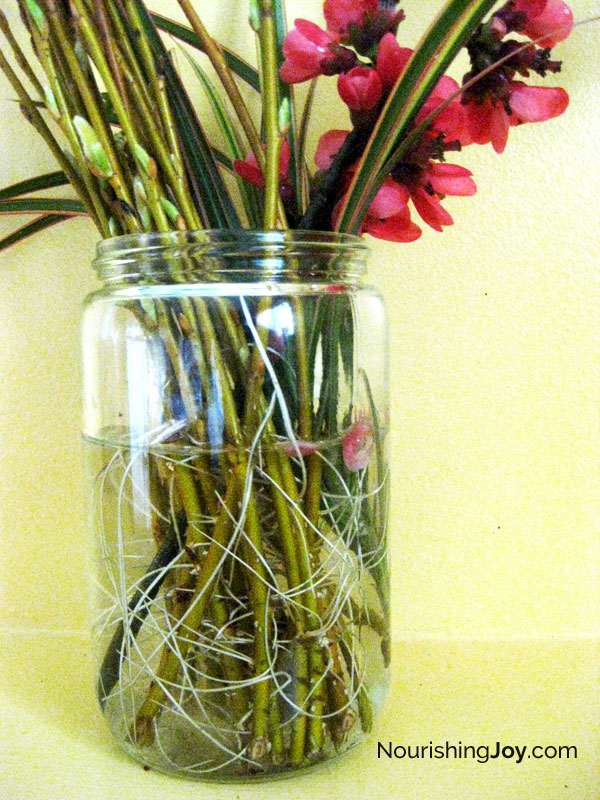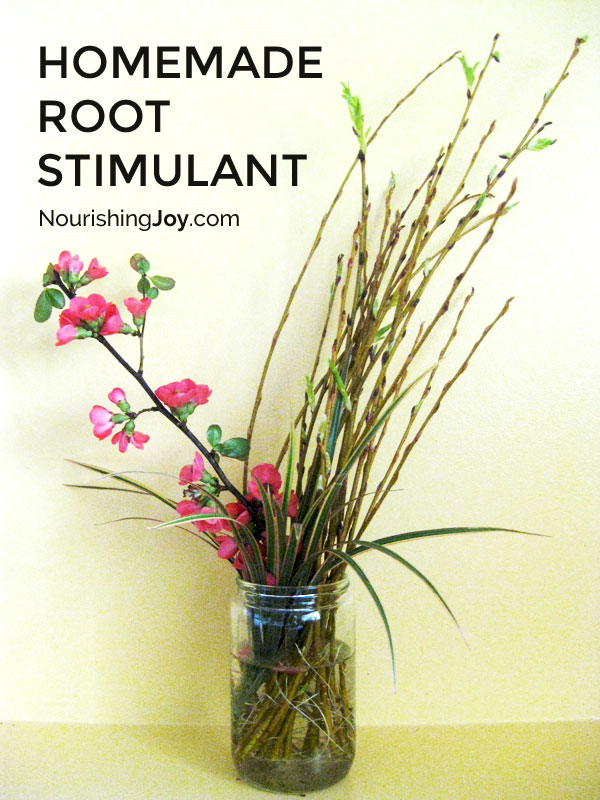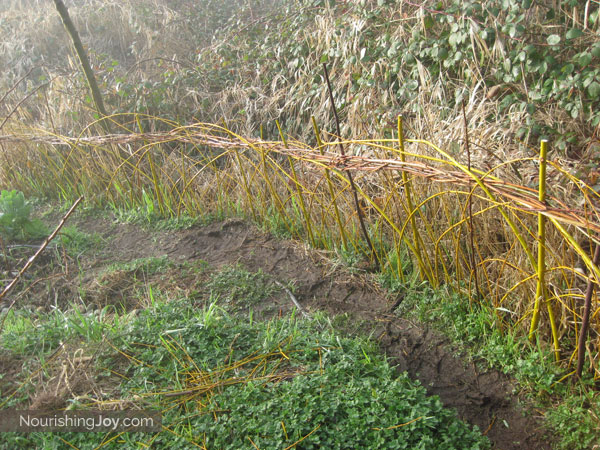How to Make Natural, Homemade Root Stimulant
This post may contain affiliate links, including those from Amazon.com, which means we earn a small commission off your purchases. And here's the thing: We only mention services and products that we think are truly worth your attention, whether they're free, paid, or otherwise. This site relies on YOUR trust, so if we don't stand behind a product 110%, it's not mentioned. Period.
It's early spring – the ground is beginning to thaw here near the 49th Parallel, the land is turning green, and blossoms are beginning to appear.
Thus, it's the perfect time to think about preparing for this year's garden. Wahoo!
Of course, heirloom seed catalogs abound and you can start planning what kind of garden you want to grow this year and maybe even prep your homemade potting soil so you're ready to go when your seeds arrive.
But what about:
- Propagating plants you already have and you want more of (like that rosemary bush or the quince tree I've got in the picture above)?
- Or for plants you can't find seeds for?
- Or you just want to get a head start on some tough-to-grow plants?
In those instances, rooting hormone or root stimulant becomes your best friend.
The problem is, most commercial varieties of root stimulant include pesticides, which theoretically can be helpful so that nothing comes and munches your newly rooted plants while they're getting established, but overall are quite harmful, as they drive away worms and other essential, beneficial organisms AND can deplete your soil of needed nutrients. They also use synthetic plant hormones at times – not to mention that they can be expensive!
So, for all these reasons, I choose a natural, homemade version, that interestingly enough, has been the way plants have been rooted for centuries – AND provides its own self-defense mechanism for protecting the infant plant as it gets established.
This natural, homemade root stimulant uses willow shoots, which are the most potent in the spring when the new shoots begin to leaf out but can be made anytime of year, provided you use that year's new growth. Older shoots are not potent enough to make the homemade root stimulant, unfortunately.
Willow is fascinating, actually, and as I've learned more about it over the last few years, I consider willow trees to be an essential part of any homestead, if the land will support them!
Hippocrates himself wrote back near 400 BC that chewing the bark of a willow tree reduced pain and fever. Phamacological records of Egyptian pharoahs indicate that willow was used to treat fever even back around 2000 BC. Yet the effective compound in willow, salicin, wasn't isolated from willow bark until the late 19th century. Today, we know this ingredient as Aspirin (or ASA – acetylsalicylic acid – as it is known in many countries).
But while that is interesting in and of itself, it is the rooting properties that are especially fascinating.
Willow can help OTHER plants grow roots, know as the “willow rooting cofactor,” and it contains two substances in particular that make the rooting process work: indolebutyric acid (IBA) and the aforementioned salicylic acid (SA).
Indolebutyric acid (IBA) is a plant hormone that stimulates root growth and is present in very high concentrations in the growing tips of willow branches. When coppiced (cut down to ground level), willow can grow more than a metre in a single season, so its concentration of growth hormone is certainly evidenced!
In fact, according to The Reference Manual of Woody Plant Propagation, THE definitive text on this type of plant propagation (don't have a copy? grab one NOW!), willows have a rooting percentage of 90-100% and adding any other rooting hormones doesn't increase the success rate whatsoever – meaning, their hormones are strong and sufficient enough that no additional hormones are needed to propagate them.
Salicylic acid (SA) not only is beneficial for treating pain and fever, as mentioned earlier, but it's a plant hormone responsible for signalling a plant’s defenses, sometimes referred to as “systemic acquired resistance,” where an attack on one part of the plant triggers the plant’s internal defenses in other parts of the plant, namely a resistance to invaders.
(It's a plant's version of a medieval castle raising its drawbridge and filling the moat when there's a sign of an attacking horde approaching. This response is strong enough that it can effectively protect other nearby plants, at times, as well.)
So, this is what makes homemade root stimulant made with willow so effective: not only does a cutting need to be given incentive to grow strong roots, but it needs to protect itself from infection by both bacteria and fungi, two very common threats to newly propogated cuttings. By infusing water with these two potent natural substances from willow, plants can better fight off infection and grow hardy roots that will sufficiently feed and nourish the plant once it's transplanted.
And even better, a little bit of willow can go a very long way. Once you have one willow shoot, you can easily make more to have a ready supply. Merely root the willow shoot in water, plant it, and at the end of the season coppice it. Now you have a cut shoot with which to make more willow water, but the coppiced stump will also grow a whole collection of new shoots the next spring. You can even do this mid-season.
Check out this willow fence my permaculture design-loving husband built from willow that he started with just a handful of shoots rooted in a 5-gallon bucket only a year before:
And, due to both indolebutyric acid and salicylic acid, willow fences around a garden help provide a sturdy barrier to repel pests of multiple kinds!
Oh, and one last note before we move on – do you see the photo at the top of this article, the one with willow branches in a jar with a quince cutting and a spider plant? Do you notice how clear the water is?
That picture was taken when the willow had been in the water for 29 days and the quince had been there for 12!!! It was part experimentation and part forgetfulness, but it was living proof that willow cleans the water, as is known when it's next to ponds or standing water (similar to cattails).
Here's a close-up:



As you can tell, I'm thoroughly impressed and fascinated with how willow is designed to be SO beneficial – and so practical – within the plant kingdom.
But, enough. We need to get on to our recipes!
How to Make Natural, Homemade Root Stimulant
For quick use:
Take one young willow shoot, removing any leaves, and cut it into 1-2″ pieces. Half-fill a quart-sized mason jar with the pieces and pour freshly boiled water over them, as if you were making tea.
(You may use any willow variety – if it has Salix in its Latin name, it is sufficient for this purpose. Also, the bark should be yellow or green. If the bark is brown or gray, it is too old.)
Steep for 8-12 hours, then strain and compost the willow pieces. The willow water root stimulant is now ready for use.
Store in the refrigerator for up to two months.
For semi-quick use:
Take one young willow shoot, removing any leaves, and cut it into 1-2″ pieces. Half-fill a quart-sized mason jar with the pieces and fill the jar with cool or tepid water.
Let sit for 5-7 days, then strain and compost the willow pieces. The willow water root stimulant is now ready for use.
Store in the refrigerator for up to two months.
If you're not in a hurry:
Place several young willow cuttings in a jar along with freshly-cut cuttings you'd like to propogate and fill the jar with water, making sure no leaves sit below the water's surface.
Let sit until the cutting forms roots at least 1″ long, 5-30 days. New cuttings may be added to the jar if the water is still clear.
How to Use Homemade Root Stimulant:
To use, pour a few inches of homemade root stimulant into a jar and place healthy cuttings into the water as you would flowers in a vase. Let sit until roots form, 1-7 days.
Please note that while willow water has been shown to be consistent more than 90% of the time, it may not perform 100% of the time, in which case a new batch will be needed.
You may also place cuttings directly in your potting soil or planting medium and then water them using the homemade root stimulant, but I've only seen mixed success on this method (although it's certainly much much better than just watering with water when you're trying to stimulate growth!).
On a similar subject and with a similar method, see Mommypotamus' excellent How to Grow Elderberries from Cuttings.
How to Find Willow Shoots if You Don't Already Have Any
Part of the reason for doing this is to save money, so don't buy willow if you don't have to (and if you do, buy as little as possible).
- Because willow grows so prolifically, it's usually fairly easy to find some by asking around on Craigslist or on gardening forums in your area.
- If a neighbor or friend has a willow tree, ask if you might cut a cutting or two.
- Or, with permission, snip a few cuttings from trees in a wilderness area, such as a county park, bird sanctuary, or even a ditch on a rural road.
Or what are your ideas? If you have an idea on how to get willow shoots ethically for free, PLEASE share in the comments below!







Hi Kresha
would you have a root stimulant for dragon fruit
Cheers
Geraldine
All the tips above work for any types of plants, including woody stem shrubs and trees. 🙂
I’ve been using chemical rooting hormone, but I’ve heard that it’s carcinogenic so I’ve recently started experimenting with natural methods. I’ll definitely give willow a try.
I’ve also heard that basil tea works in the same way. Do you have any experience of this?
I don’t! But please do let us know how it goes if you try it!
what type of aspirin can be used if wilow is not available?
Aspirin is simply a brand-name for “acetylsalicylic acid.” In fact, in many countries outside the US, it’s often simply referred to as “ASA.” So, any acetylsalicylic acid product, preferably with no other additives, will work just fine – Aspirin brand, generic, or other. 🙂
Question: Due to location and convenience, we got more willow shoots (actually baby willows that were no taller than 2.5 feet tall). We ended up with about 4 inches of cut pieces in the bottom of a bucket. Should we just soak them in however much water tops off the bucket – then dramatically dilute the solution after the soaking? Or maybe just “dose” the plants with smaller amounts? I’m trying to encourage good root growth in potted tree saplings…
Oh, nice!
I would simply top up the bucket with water and let it sit, then use that water – no need to dilute (although you can if you want). If you’re wanting more, perhaps divide the pieces into two buckets and create two solutions?
I hope that helps!
Lover this! Looking to buy a few young willow shoots for rooting plants You have educated me thourouly! TY!
I find it difficult to propagate avocardopear and mango either by grafting or by budding,, please help me